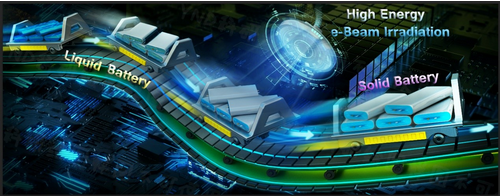《Scalable fabrication of solid-state batteries through high-energy electronic beam》
The in-situ polymerization is a promising technique for achieving industrial-scale production of solid-state lithium metal batteries (LMBs). However, initiators must be used in the most of previously reported polymerization method, which would give rise to some adverse effect on the battery. Herein, an initiator-free, simple, clean and efficient technique—high-energy electronic beam (e-beam) irradiation—is employed to in-situ prepare gel polymer electrolytes (GPEs) based on vinyl ethylene carbonate (VEC) and poly(ethyleneglycol) dimethacrylate (PEGDMA). The obtained GPEs deliver satisfactory ionic conductivity (0.17 mS cm−1 at 27 °C), high lithium-ion transference number (0.76 at 27 °C) and good electrochemical stability (5.4 V, vs Li/Li+). The LiFePO4/Li (LFP/Li) batteries based on the GPEs achieve excellent cycling stability (85% retention after 270 cycles) and rate performance. More impressively, high-energy e-beam can penetrate through aluminum-plastic film to induce polymerization, which directly leads to the transformation from the liquid-state pouch cell to the solid-state. The solid-state LFP/Li pouch cell exhibits excellent cycling performance with a capacity retention of 83% after 100 cycles at 60 °C. What is also noteworthy that the GPEs realizes good safety performance even at combustion test. Therefore, employing high-energy e-beam as an in-situ solidification technique not only opens a novel pathway to large-scale production of solid-state LMBs, but also could greatly advance the development of high-energy-density LMBs.

https://www.sciencedirect.com/science/article/pii/S1385894721058952
